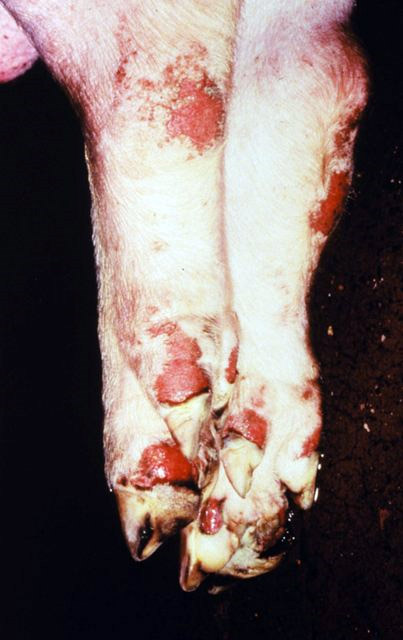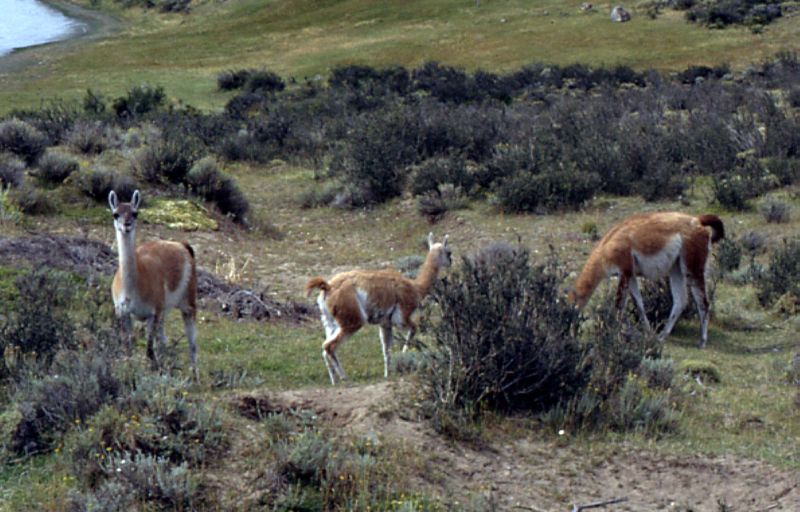|
Foot And Mouth
Foot-and-mouth disease (FMD) or hoof-and-mouth disease (HMD) is an infectious and sometimes fatal viral disease that affects cloven-hoofed animals, including domestic and wild bovids. The virus causes a high fever lasting two to six days, followed by blisters inside the mouth and near the hoof that may rupture and cause lameness. FMD has very severe implications for animal farming, since it is highly infectious and can be spread by infected animals comparatively easily through contact with contaminated farming equipment, vehicles, clothing, and feed, and by domestic and wild predators. Its containment demands considerable efforts in vaccination, strict monitoring, trade restrictions, quarantines, and the culling of both infected and healthy (uninfected) animals. Susceptible animals include cattle, water buffalo, sheep, goats, pigs, antelope, deer, and bison. It has also been known to infect hedgehogs and elephants; llamas and alpacas may develop mild symptoms, but are resistant t ... [...More Info...] [...Related Items...] OR: [Wikipedia] [Google] [Baidu] |
Picornaviridae
Picornaviruses are a group of related nonenveloped RNA viruses which infect vertebrates including fish, mammals, and birds. They are viruses that represent a large family of small, positive-sense, single-stranded RNA viruses with a 30 nm icosahedral capsid. The viruses in this family can cause a range of diseases including the common cold, poliomyelitis, meningitis, hepatitis, and paralysis. Picornaviruses constitute the family ''Picornaviridae'', order ''Picornavirales'', and realm '' Riboviria''. There are 158 species in this family, assigned to 68 genera. Notable examples are genera ''Enterovirus'' (including ''Rhinovirus'' and ''Poliovirus''), ''Aphthovirus'', ''Cardiovirus'', and ''Hepatovirus''. Etymology The name "picornavirus" has a dual etymology. Firstly, the name derives from ''picorna''- which is an acronym for "''p''oliovirus, ''i''nsensitivity to ether, ''c''oxsackievirus, ''o''rphan virus, ''r''hinovirus, and ribo''n''ucleic ''a''cid". Secondly, the ... [...More Info...] [...Related Items...] OR: [Wikipedia] [Google] [Baidu] |
Domestic Water Buffalo
The water buffalo (''Bubalus bubalis''), also called the domestic water buffalo or Asian water buffalo, is a large bovid originating in the Indian subcontinent and Southeast Asia. Today, it is also found in Europe, Australia, North America, South America and some African countries. Two extant types of water buffalo are recognized, based on morphological and behavioural criteria: the river buffalo of the Indian subcontinent and further west to the Balkans, Egypt and Italy and the swamp buffalo, found from Assam in the west through Southeast Asia to the Yangtze valley of China in the east. The wild water buffalo (''Bubalus arnee'') most likely represents the ancestor of the domestic water buffalo. Results of a phylogenetic study indicate that the river-type water buffalo probably originated in western India and was domesticated about 6,300 years ago, whereas the swamp-type originated independently from Mainland Southeast Asia and was domesticated about 3,000 to 7,000 years ag ... [...More Info...] [...Related Items...] OR: [Wikipedia] [Google] [Baidu] |
Hand, Foot, And Mouth Disease
Hand, foot, and mouth disease (HFMD) is a common infection caused by a group of enteroviruses. It typically begins with a fever and feeling generally unwell. This is followed a day or two later by flat discolored spots or bumps that may blister, on the hands, feet and mouth and occasionally buttocks and groin. Signs and symptoms normally appear 3–6 days after exposure to the virus. The rash generally resolves on its own in about a week. Fingernail and toenail loss may occur a few weeks later, but they will regrow with time. The viruses that cause HFMD are spread through close personal contact, through the air from coughing and the feces of an infected person. Contaminated objects can also spread the disease. Coxsackievirus A16 is the most common cause, and enterovirus 71 is the second-most common cause. Other strains of coxsackievirus and enterovirus can also be responsible. Some people may carry and pass on the virus despite having no symptoms of disease. Other animals ... [...More Info...] [...Related Items...] OR: [Wikipedia] [Google] [Baidu] |
Foot-and-mouth Disease Virus
''Foot-and-mouth disease virus'' (FMDV) is the pathogen that causes foot-and-mouth disease. It is a picornavirus, the prototypical member of the genus ''Aphthovirus''. The disease, which causes vesicles (blisters) in the mouth and feet of cattle, pigs, sheep, goats, and other cloven-hoofed animals is highly infectious and a major plague of animal farming. Structure and genome The virus particle (25-30 nm) has an icosahedral capsid made of protein, without envelope, containing a positive-sense (mRNA sense) single-stranded ribonucleic acid (RNA) genome. Replication When the virus comes in contact with the membrane of a host cell, it binds to a receptor site and triggers a folding-in of the membrane. Once the virus is inside the host cell, the capsid dissolves, and the RNA gets replicated, and translated into viral proteins by the cell's ribosomes using a cap-independent mechanism driven by the internal ribosome entry site element. The synthesis of viral proteins ... [...More Info...] [...Related Items...] OR: [Wikipedia] [Google] [Baidu] |
Chicken
The chicken (''Gallus gallus domesticus'') is a domesticated junglefowl species, with attributes of wild species such as the grey and the Ceylon junglefowl that are originally from Southeastern Asia. Rooster or cock is a term for an adult male bird, and a younger male may be called a cockerel. A male that has been castrated is a capon. An adult female bird is called a hen and a sexually immature female is called a pullet. Humans now keep chickens primarily as a source of food (consuming both their meat and eggs) and as pets. Traditionally they were also bred for cockfighting, which is still practiced in some places. Chickens are one of the most common and widespread domestic animals, with a total population of 23.7 billion , up from more than 19 billion in 2011. There are more chickens in the world than any other bird. There are numerous cultural references to chickens – in myth, folklore and religion, and in language and literature. Genetic studies have pointed to mult ... [...More Info...] [...Related Items...] OR: [Wikipedia] [Google] [Baidu] |
Mice
A mouse ( : mice) is a small rodent. Characteristically, mice are known to have a pointed snout, small rounded ears, a body-length scaly tail, and a high breeding rate. The best known mouse species is the common house mouse (''Mus musculus''). Mice are also popular as pets. In some places, certain kinds of field mice are locally common. They are known to invade homes for food and shelter. Mice are typically distinguished from rats by their size. Generally, when a muroid rodent is discovered, its common name includes the term ''mouse'' if it is smaller, or ''rat'' if it is larger. The common terms ''rat'' and ''mouse'' are not taxonomically specific. Typical mice are classified in the genus '' Mus'', but the term ''mouse'' is not confined to members of ''Mus'' and can also apply to species from other genera such as the deer mouse, ''Peromyscus''. Domestic mice sold as pets often differ substantially in size from the common house mouse. This is attributable to breeding a ... [...More Info...] [...Related Items...] OR: [Wikipedia] [Google] [Baidu] |
Alpaca
The alpaca (''Lama pacos'') is a species of South American camelid mammal. It is similar to, and often confused with, the llama. However, alpacas are often noticeably smaller than llamas. The two animals are closely related and can successfully crossbreed. Both species are believed to have been domesticated from their wild relatives, the vicuña and guanaco. There are two breeds of alpaca: the Suri alpaca and the Huacaya alpaca. Alpacas are kept in herds that graze on the level heights of the Andes of Southern Peru, Western Bolivia, Ecuador, and Northern Chile at an altitude of above sea level. Alpacas are considerably smaller than llamas, and unlike llamas, they were not bred to be working animals, but were bred specifically for their fiber. Alpaca fiber is used for making knitted and woven items, similar to sheep's wool. These items include blankets, sweaters, hats, gloves, scarves, a wide variety of textiles, and ponchos, in South America, as well as sweaters, socks, coat ... [...More Info...] [...Related Items...] OR: [Wikipedia] [Google] [Baidu] |
Llama
The llama (; ) (''Lama glama'') is a domesticated South American camelid, widely used as a List of meat animals, meat and pack animal by Inca empire, Andean cultures since the Pre-Columbian era. Llamas are social animals and live with others as a herd. Their wool is soft and contains only a small amount of lanolin. Llamas can learn simple tasks after a few repetitions. When using a pack, they can carry about 25 to 30% of their body weight for 8 to 13 kilometre, km (5–8 miles). The name ''llama'' (in the past also spelled "lama" or "glama") was adopted by European colonization of the Americas, European settlers from Indigenous people in Peru, native Peruvians. The ancestors of llamas are thought to have originated from the Great Plains of North America about 40 million years ago, and subsequently migrated to South America about three million years ago during the Great American Interchange. By the end of the last Quaternary glaciation, ice age (10,000–12,000 years ago), ... [...More Info...] [...Related Items...] OR: [Wikipedia] [Google] [Baidu] |
Elephant
Elephants are the largest existing land animals. Three living species are currently recognised: the African bush elephant, the African forest elephant, and the Asian elephant. They are the only surviving members of the family Elephantidae and the order Proboscidea. The order was formerly much more diverse during the Pleistocene, but most species became extinct during the Late Pleistocene epoch. Distinctive features of elephants include a long proboscis called a trunk, tusks, large ear flaps, pillar-like legs, and tough but sensitive skin. The trunk is used for breathing, bringing food and water to the mouth, and grasping objects. Tusks, which are derived from the incisor teeth, serve both as weapons and as tools for moving objects and digging. The large ear flaps assist in maintaining a constant body temperature as well as in communication. African elephants have larger ears and concave backs, whereas Asian elephants have smaller ears, and convex or level backs. Elephants ... [...More Info...] [...Related Items...] OR: [Wikipedia] [Google] [Baidu] |
Hedgehog
A hedgehog is a spiny mammal of the subfamily Erinaceinae, in the eulipotyphlan family Erinaceidae. There are seventeen species of hedgehog in five genera found throughout parts of Europe, Asia, and Africa, and in New Zealand by introduction. There are no hedgehogs native to Australia and no living species native to the Americas. However, the extinct genus ''Amphechinus'' was once present in North America. Hedgehogs share distant ancestry with shrews (family Soricidae), with gymnures possibly being the intermediate link, and they have changed little over the last fifteen million years. Like many of the first mammals, they have adapted to a nocturnal way of life. Their spiny protection resembles that of porcupines, which are rodents, and echidnas, a type of monotreme. Etymology The name ''hedgehog'' came into use around the year 1450, derived from the Middle English ''heyghoge'', from ''heyg'', ''hegge'' ("hedge"), because it frequents hedgerows, and ''hoge'', ''hogge'' ... [...More Info...] [...Related Items...] OR: [Wikipedia] [Google] [Baidu] |


.jpg)





_colourised.png)
